Last weekend I ran the Winschoten 50 km, a road ultra here in The Netherlands. I had originally signed up for the 100 km but then changed my plans given a summer of running issues (see here). Eventually, the race went really well, as I finished 4th on quite a hot day, and reached my goal of sub-4 hours (3h 58’, see here).
This blog covers the race and my training leading up to it.
Race Overview
The Winschoten 50 km is a road ultra on a flat, fast course, structured in loops of 10 km. This is not the type of event I’d normally do, but at the beginning of summer, after racing the Biel 100 km (race report here), I thought it would be a good opportunity to test pacing and fueling without risking much (if anything goes wrong, you can easily call it a day). For context, my main goal for next year remains the 100 km del Passatore, which takes place in May in Italy, and most of what I do during the year aims at better preparing for this event.
Anyways, eventually, the Winschoten 50 km turned out to be quite a bit more useful than expected, as we had a heat wave in The Netherlands just this week, and I got to race in the heat, which never happens here. This is more likely to happen for Passatore, and so I tried to embrace it and see what I could do.
Heat
When preparing for Passatore, I tried a passive heat protocol that I thought worked quite well (covered here). However, given that the likelihood of 30C in September here in The Netherlands is near zero, this time I didn’t do any passive acclimation.
As someone who suffers from the heat a lot, sweats a lot and loses a lot of sodium, I figured it was going to be a nightmare. Surprisingly, I didn’t really suffer the heat until maybe a bit during the last lap, but not really much (granted, it wasn’t that hot at the beginning, but coming from a cold summer, a few degrees can make a big difference in perception).
I think that the main reason for being partially heat-adapted has been my cycling training in the week leading to the race. During this period, I ran little as I had even more issues with my injuries, but I spent about 15 hours on the bike, most of them at 28-30C. Given the time it takes to get some sort of response to the heat, and that we had a ~7-day heat wave, I probably benefitted from that training and got to the race in better conditions than I thought.
I wouldn’t recommend going into a hot race unprepared, but again, quite an outlier around here (the last time we had similar temperatures this time of the year was in 1958).
I didn’t think about this until after the race, but I now consider this a good way to prepare in the future as well, e.g. do a structured passive heat protocol in the bathtub, keep training hard early in the morning when it’s cooler, and then add cycling in the warmer / hot hours of the day to get some extra benefits without stressing the body much. I plan to do this for next year’s Passatore.
Learnings: add cycling in the heat for heat acclimation with limited stress on the body.
Fueling
It took me a while to figure out fueling for an ultra. I tried real food, engineered food (energy bars, powders), gels, all of the above mixed up and at different frequencies. An important factor to consider here is also how everything changes dramatically on a hot day, as your body diverts blood away from the gut not only to the muscles but also to the skin for cooling, making it even harder to eat / digest while running. Something I learned the hard way is that if you have a good protocol for a cold day, it might not work on a hot day.
After two years of trial and error (some documented here, and here), I have something that works well now. For this race, I used the same protocol I used for the Biel 100 km and I had 1 gel every 6 km, and nothing else. I do allow for flexibility based on how I feel, for example, I started eating after 8 km instead of 6 km as I probably had a bit too much oatmeal for breakfast, and then I skipped a gel at the end and the one before the start. The main point for me is not to use any solid food but only gels, and then to make small changes based on how I feel in terms of hunger. I think this works well for up to 10 hours, which is as much as I am going to race for the foreseeable future. For longer races, things would be different, but again, that’s not what I am currently interested in.
I had 7 gels total, two of them with caffeine (100 mg each). I find these quite essential to get me clear-headed when fatigue starts to creep in. I always felt quite a strong kick from caffeine, but this is even stronger now that I do not drink coffee habitually.
I do not know exactly how much I drank, as I took water at all opportunities on the course (given the heat), but you know how it is when you are drinking from paper cups while running, most of it ends up on the asphalt. I suspect I was a bit dehydrated by the end, as I also felt quite thirsty.
Learnings: keep using only gels and alternate regular ones with caffeinated gels.
Gear
Given the hot day, I also took the opportunity to try a t-shirt from Inuteq, which is supposed to keep you cool for a couple of hours. Basically, you put the t-shirt in water just before wearing it and then go. This race was the perfect setup for this type of experiment, as I could just get the t-shirt from my crew after a few laps, without even stopping. I planned to try it out after 30 km, so for the 4th and 5th lap, but after the 4th lap decided to take it off as I wasn’t really feeling cooler (just heavier, if anything). This was also a useful test for Passatore, now I know I do not need to bother with this and I can wear a normal t-shirt. On a side note, what helped massively for cooling were the hundreds of kids giving away sponges on the course.
In terms of shoes, I ran in Hoka’s Rincons, which I had also for the Biel 100 km. I am still trying to find a shoe that is not too heavy and that works decently with my flat feet, but this one is not it. I like the shoe and used it a lot in the past, but I have issues especially with the right foot (which is the flattest), eventually causing me to work harder with the muscles in the inner side of my thigh, which is what cramped really bad in the last lap (see later for more details), as well as in other occasions. Anyways, the perfect shoe for me to use in a road ultra is still something I need to sort out before the next Passatore.
Learnings: no need for special t-shirts, but try to keep the head cool with water or sponges. Still have to find the right shoe for the distance.
Pacing
I planned to pace my race based on heart rate (and of course perceived exertion). Based on the past year of training and racing, I know I can race a marathon with a cap of 158-160 bpm (see my blog on finding marathon intensity, here), and a 100 km with a cap of approximately 140 bpm. A 50 km for me is raced mostly at the very high end of zone 2, slipping into zone 3 in the final part of the race. The idea was to then keep the heart rate below 145 bpm for the first lap or two, then slip in the low 150s for the third and fourth, and then don’t bother with it with the last lap, when the temperature was also going to be higher. I thought this would correspond to a pace of 4:35-4:45 min/km, which was indeed spot on. For context, I never train in zone 2 or high-end zone 2, so it was a bit uncharted territory for me.
I am very happy with how this turned out as my pacing was really even all the time, apart from when I cramped terribly at km 42 and 49:

I might blog more in the future about cramping, something I’ve had to deal with since I started running. The only comment I’ll add here for now is that at 42 km when I froze in the middle of the road for 2 minutes, I thought I was done and would just have to walk it back to the start. Somewhat surprisingly, I waited, stretched, and continued running more or less at the same pace I was running earlier, just paying a little more attention not to overexert myself. Given a summer of cycling more than running, an unexpectedly hot day, and a race raced near my limit for the distance, I cannot complain.
As I mentioned elsewhere, I also took Maurten bicarb pre-race, which had a dramatic positive impact on my cramps (some say it is probably just the absurd amount of sodium, others say it might be the impact on the acidity otherwise generated by intensities above first lactate threshold, I do not have an answer, but I am seeing a consistent positive effect at this point). If you cramp systematically in every long tempo run, I’d be curious to hear what happens if you give this a try. Research is unlikely to answer this question for us, given the poor ecological validity and limited sample size of studies on cramps.
Learnings: experiment more with sodium pre-loading, keep using Maurten bicarb before racing, and keep pacing based on a slightly conservative heart rate cap.
Training
Below I cover my training at a very high level. If you are interested in the details, my training log is available on Strava here, while my training diary for 2023 is available on Substack here.
Since I got injured on July 17th, almost two months ago, I have mostly cycled. I was running 60-70 hours per month before the injury and went down to 26 and 42 hours in the past two months. I was not cycling at all before, but I have cycled about 65 hours per month in the past two months:
I thrive with high volume (both mentally and physically, but maybe mentally above all), and my training tends to reflect this. The vast majority of my cycling was low intensity, with a Zwift workout of about 35-45 minutes once per week (more details about cross-training, here):

In terms of running workouts, I consider them as important as volume, as I can otherwise quickly drift into becoming quite slow, as happened last year when I wasn’t able to do any intensity for several months. Training hard for me doesn’t mean doing workouts every two days, but trying to maintain a well-done hard session every 7-10 days seems to be enough. However, due to the injuries and some setbacks when I tried to run harder over the summer, I have done almost no running workouts in the past two months.
The past three weeks were a bit better and I was hitting 100 km of running per week and was able to do one good workout every 10 days or so (I did three, a set of 800s and a set of 2000m repeats, plus a long marathon pace workout). This is not much but it was enough to feel confident about being fit, as my pace for the short workouts wasn’t far from what I was running before the sub-3 marathon.
I was a lot less confident about my durability given how fatigued I felt while running long or at the end of the workouts (I cover this here in my cross-training blog post), at least until last Sunday, when I surprised myself with a strong marathon pace workout (this one). After the workout I was quite battered, so I did almost no running all week (still with plenty of cycling), but I knew I could race sub-4 hours for 50 km if I was going to start the race feeling healthy and manage the heat well. I slowly got better during the week and felt normal on Friday, the day before the race, hence I went for it on Saturday.

In terms of tapering, I did what I normally do, i.e. no tapering apart from 2-3 days of very little running before the race (in this case I would have done the same regardless, given injuries and fatigue due to non-training related stressors). I kept cycling, including 2-3 hours the afternoon before the race, and the day before that. I ran my hardest workout of the summer 6 days before the race (the marathon pace workout described above):

At this point I consider this injury a blessing in disguise, it forced me to cycle enough to end up liking it and to learn how to possibly structure my training in a way that is more sustainable (i.e. risking fewer running injuries), while still improving my running. I was terrified of de-training or of losing running economy by not running and cycling more, but even for someone whose running economy is quite poor (see here), there is probably a point when running more is not worth it while doing (lots) of cross-training can make me a better runner. I will try to find the right balance in the next year or two as I structure my life and training slightly differently. I do not think we can replace running with cycling, but adding lots of cycling while possibly reducing a bit running, is another story.
Learnings: cycling cycling cycling.
Alright, that’s all for this race and training report. Taking a few days off running now, cycling to keep my mind calm, and then focusing on the Chicago marathon which is in less than 4 weeks, hoping my calf holds up.
Let’s keep training and let’s keep learning.
Marco holds a PhD cum laude in applied machine learning, a M.Sc. cum laude in computer science engineering, and a M.Sc. cum laude in human movement sciences and high-performance coaching.
He has published more than 50 papers and patents at the intersection between physiology, health, technology, and human performance.
He is co-founder of HRV4Training, advisor at Oura, guest lecturer at VU Amsterdam, and editor for IEEE Pervasive Computing Magazine. He loves running.
Social:

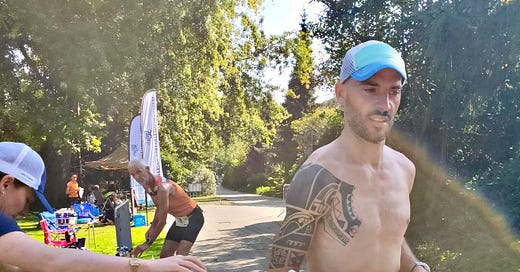


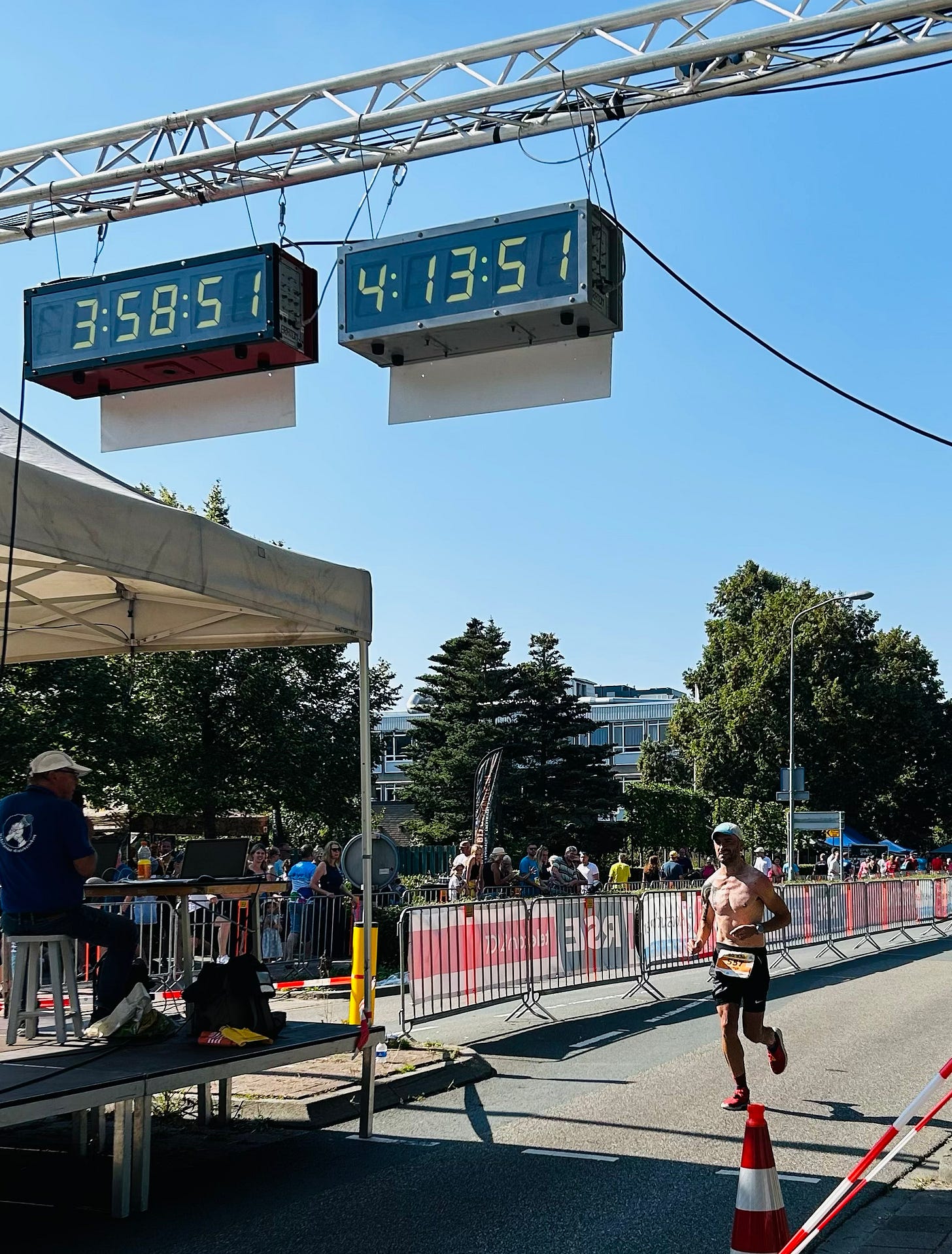



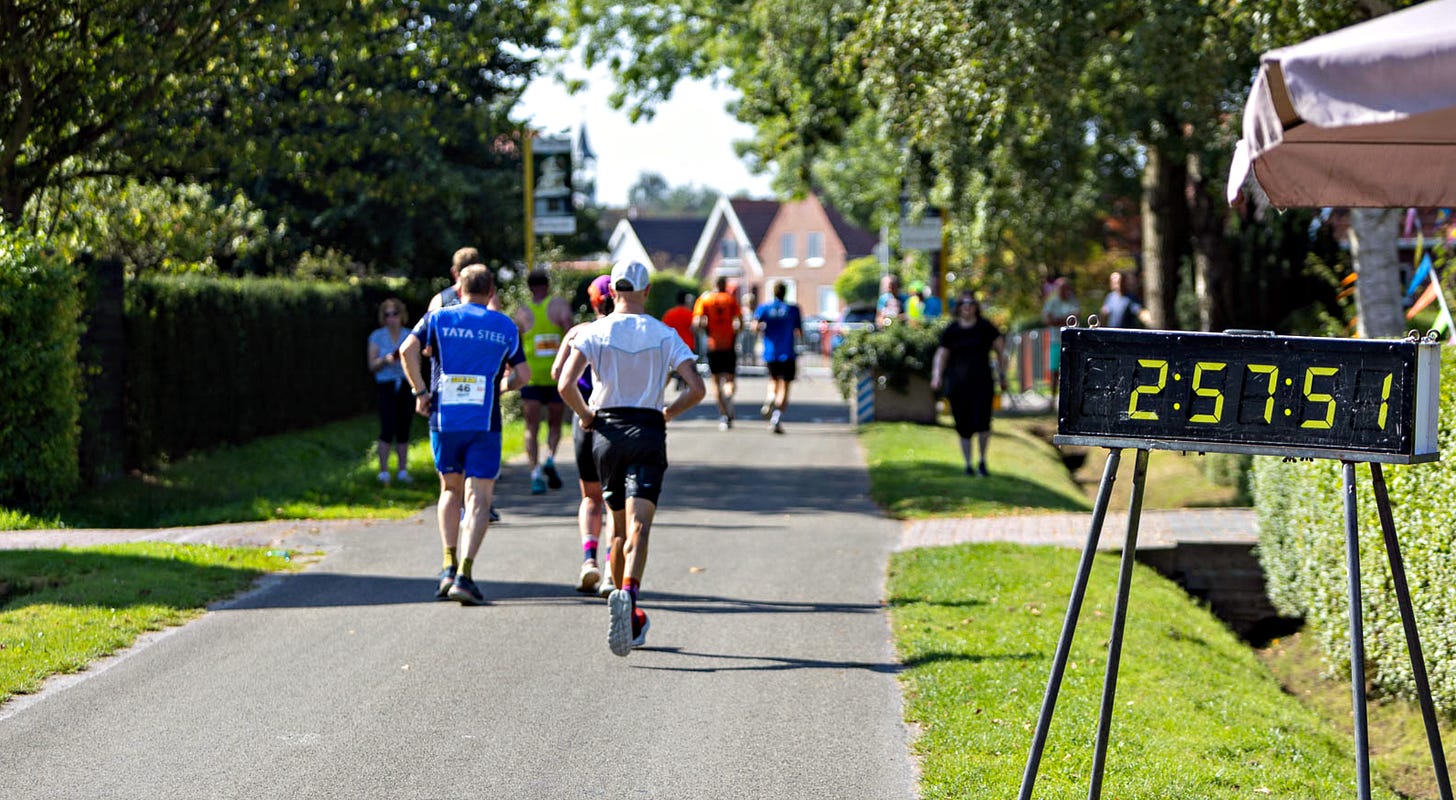
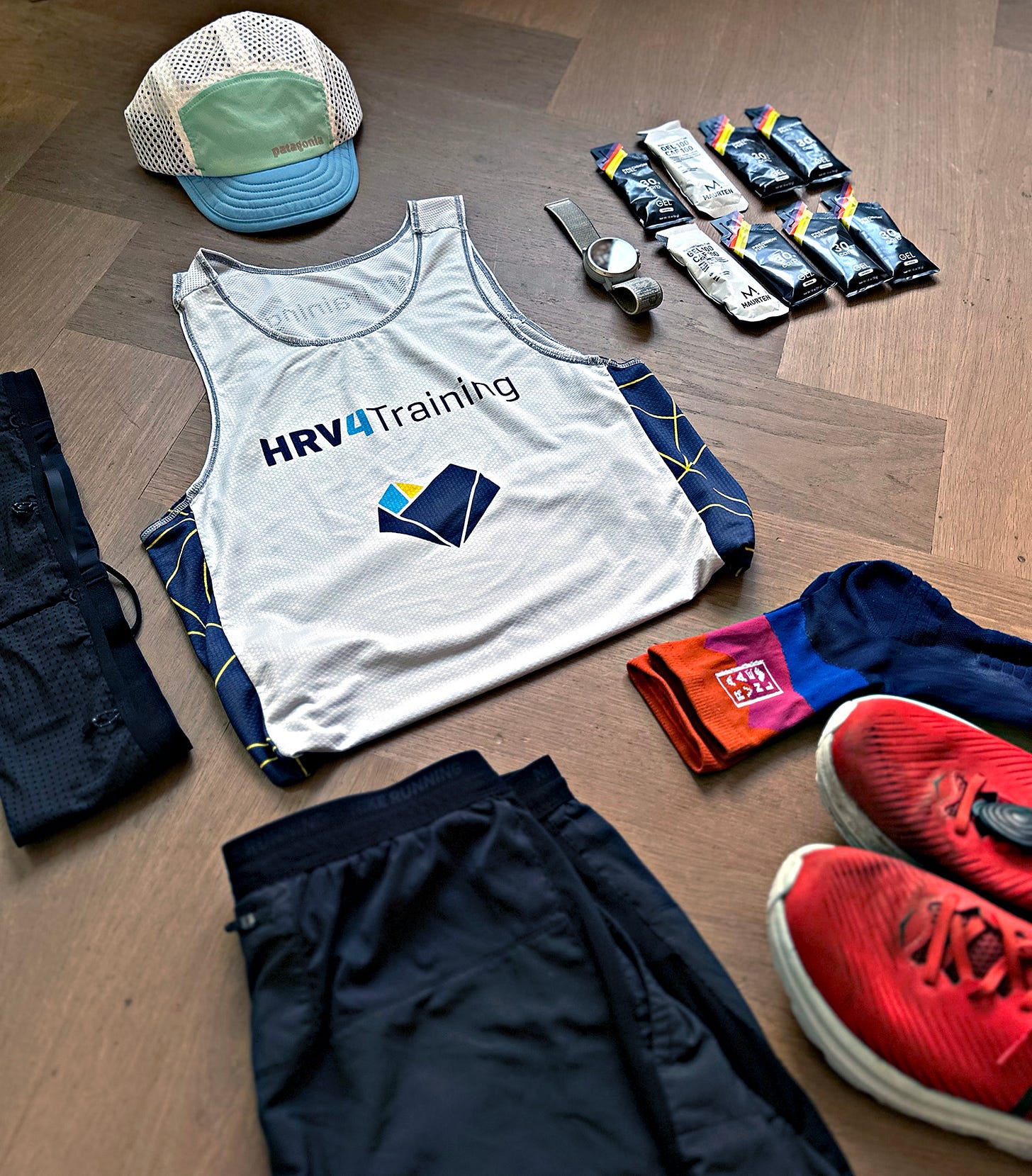

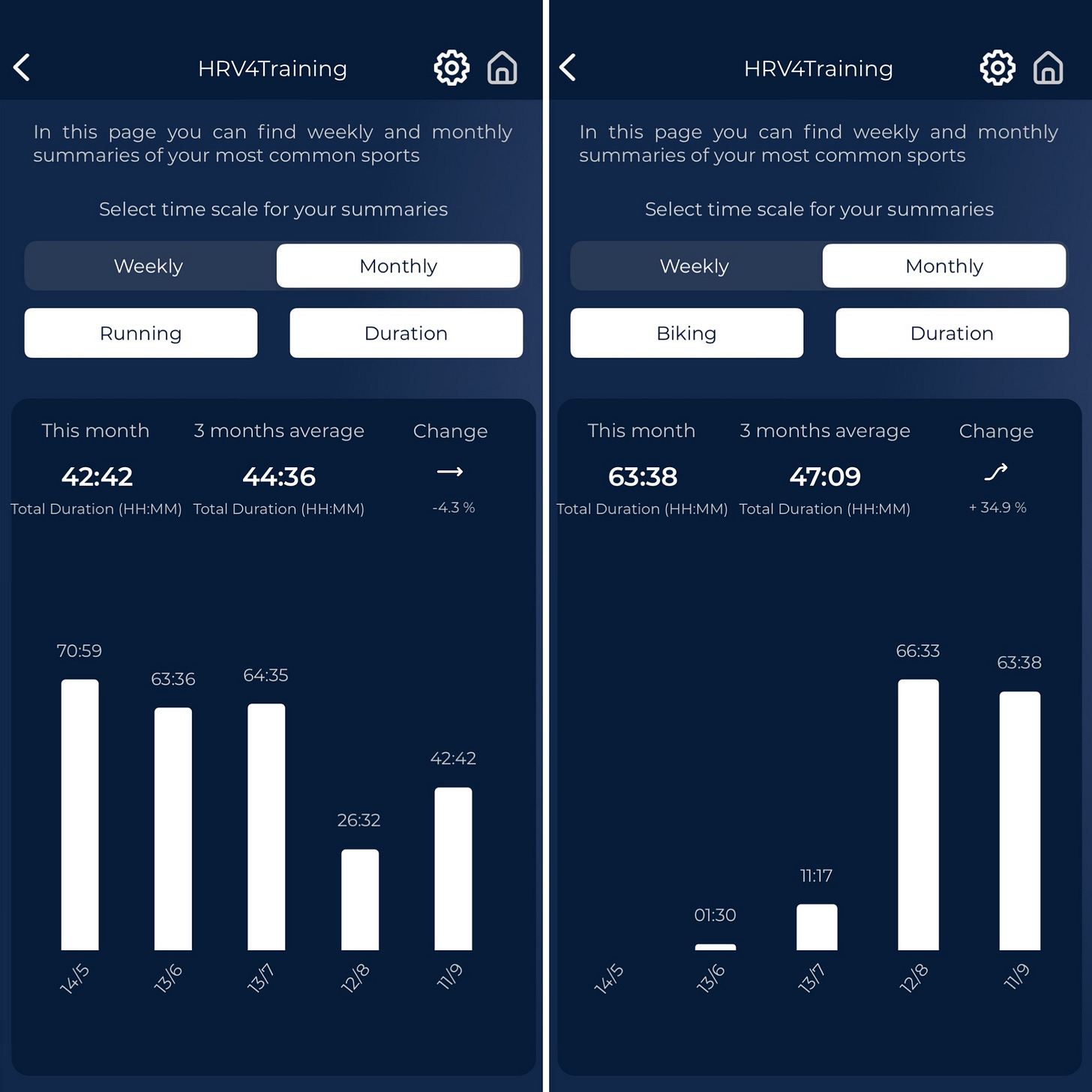


Great race congrats. Seems like you doubled your usual running volume with cycling. You think that level of cycling volume is necessary to reap the running benefits?
Perfectly covered all the aspects of training. Thank you for sharing your experience in details! Learning a lot from your part of training and will try to implement in my tranining regiment in near future. At the moment, I'm focusing on loosing weight :)